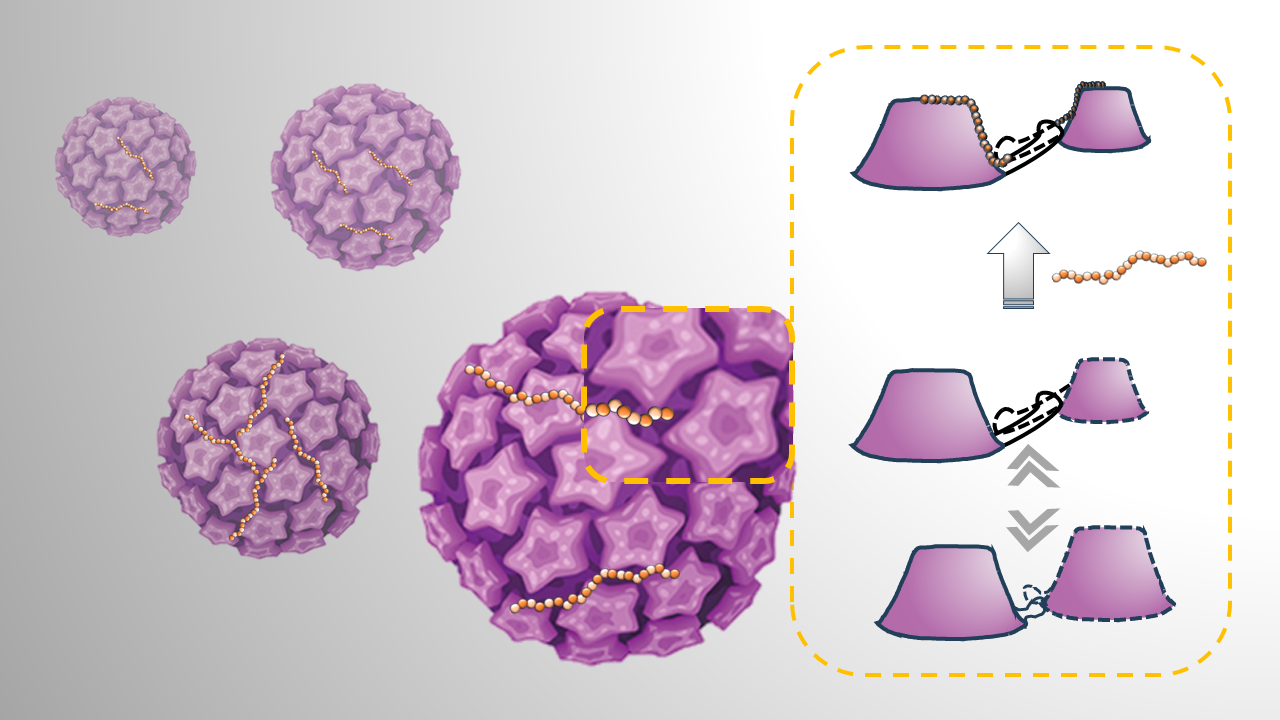Glycans soften papilloma virus by stabilizing extended structure
Scientists from the Molecular Biophysics lab of the Zernike Institute and their international collaborators reveal key insights into the molecular interactions taking place during the initial steps of Human Papillomavirus (HPV) infection. Their findings were published in the scientific journal Nature Communications.
HPVs are a large family of DNA viruses that cause diseases ranging from asymptomatic infections to throat or genital cancers. While vaccines are available to prevent HPV infection, the development of additional anti-viral strategies is highly desirable. To gain a deeper understanding of the initial interactions between HPV and host basal cells, the researchers in the Roos group (Molecular Biophysics, Zernike Institute) in collaboration with scientists from the CSSB Hamburg and the Universität Münster investigated the role played by cellular heparan sulphates (HS) in facilitating HPV entry. Employing a combination of virological assays, hydrogen/deuterium exchange mass spectromerty and atomic force microscopy the researchers determined the effect of viral capsid-HS bonding and structural activation.

HPV capsids initially bind to cells via heparan sulphate (HS), which are linear polysaccharides residing on the cellular surface. “We understood that this interaction between HPVs and HS results in conformational changes in the virus capsid,” notes one of the studies first authors Dominik van Bodegraven from the Universität Münster “however, these interactions were ill-defined and their molecular nature as well as their specific function remained unclear.”
The researchers used an atomic force microscope (AFM) to image HS-bound HPVs at the single virus level and to measure viral mechanical properties such as the viral spring constant, a measure of a virus’s stiffness. “We show that the engagement of several binding sites by a minimum length of HS polysaccharide is needed for structural activation,” explains first author Yuzhen Feng from the Zernike Institute for Advanced Materials at the Rijksuniversiteit Groningen.
Further investigation of the interaction via hydrogen/deuterium exchange mass spectromerty, which maps the local changes of structure and dynamics in proteins, revealed that the binding of HS to HPV capsomeres imparts a reversible pincer-like force. “This force stabilizes the viral capsid in a conformation with extended capsomer linkers,” explains first author Alan Kadek, a former member of CSSB’s Uetrecht group and now at the Institute of Microbiology of the Czech Academy of Sciences, “The capsid is therefore both enlarged and softened which ultimately facilitates viral entry into the host cell.”
“It is fascinating to see how by using these complementary techniques, we were able to gain these deeper insights into the HPV viral life cycle”, says Wouter Roos. Roos is the shared last author on the manuscript and leads a group focusing on mechanics and dynamics at the nano- to microscale at the Zernike Institute. One of the main techniques in his lab is atomic force microscopy (AFM), which was used in this study for the mechanical characterisation of the viral particles by an approach called nanoindentation. “Overall, this work reveals new mechanistic insights into the initial steps of HPV infection that will likely advance fundamental science, and moreover may help further the design of novel small compound inhibitors to help combat HPV infections” notes Charlotte Uetrecht, CSSB Group leader and one of the study’s corresponding authors.
Original Publication:
Yuzhen Feng, Dominik van Bodegraven, Alan Kádek, Ignacio L.B. Munguira, Laura Soria-Martinez, Sarah Nentwich, Sreedeepa Saha, Florian Chardon, Daniel Kavan, Charlotte Uetrecht, Mario Schelhaas, Wouter H. Roos
Glycan-induced structural activation softens the human papillomavirus capsid for entry through reduction of intercapsomere flexibility.
Nature Communications 15, 10076 (2024)
| Last modified: | 12 December 2024 10.08 a.m. |
More news
-
24 March 2025
UG 28th in World's Most International Universities 2025 rankings
The University of Groningen has been ranked 28th in the World's Most International Universities 2025 by Times Higher Education. With this, the UG leaves behind institutions such as MIT and Harvard. The 28th place marks an increase of five places: in...
-
05 March 2025
Women in Science
The UG celebrates International Women’s Day with a special photo series: Women in Science.
-
16 December 2024
Jouke de Vries: ‘The University will have to be flexible’
2024 was a festive year for the University of Groningen. In this podcast, Jouke de Vries, the chair of the Executive Board, looks back.
